COIT20261 Network Routing and Switching Term 1, 2019
VerifiedAdded on 2023/01/06
|5
|1350
|2
AI Summary
This document is the answer template for Assignment Two of COIT20261 Network Routing and Switching Term 1, 2019. It includes marking criteria, questions, and answers related to routing tables, router functions, autonomous systems, interdomain and intradomain routing protocols.
Contribute Materials
Your contribution can guide someone’s learning journey. Share your
documents today.
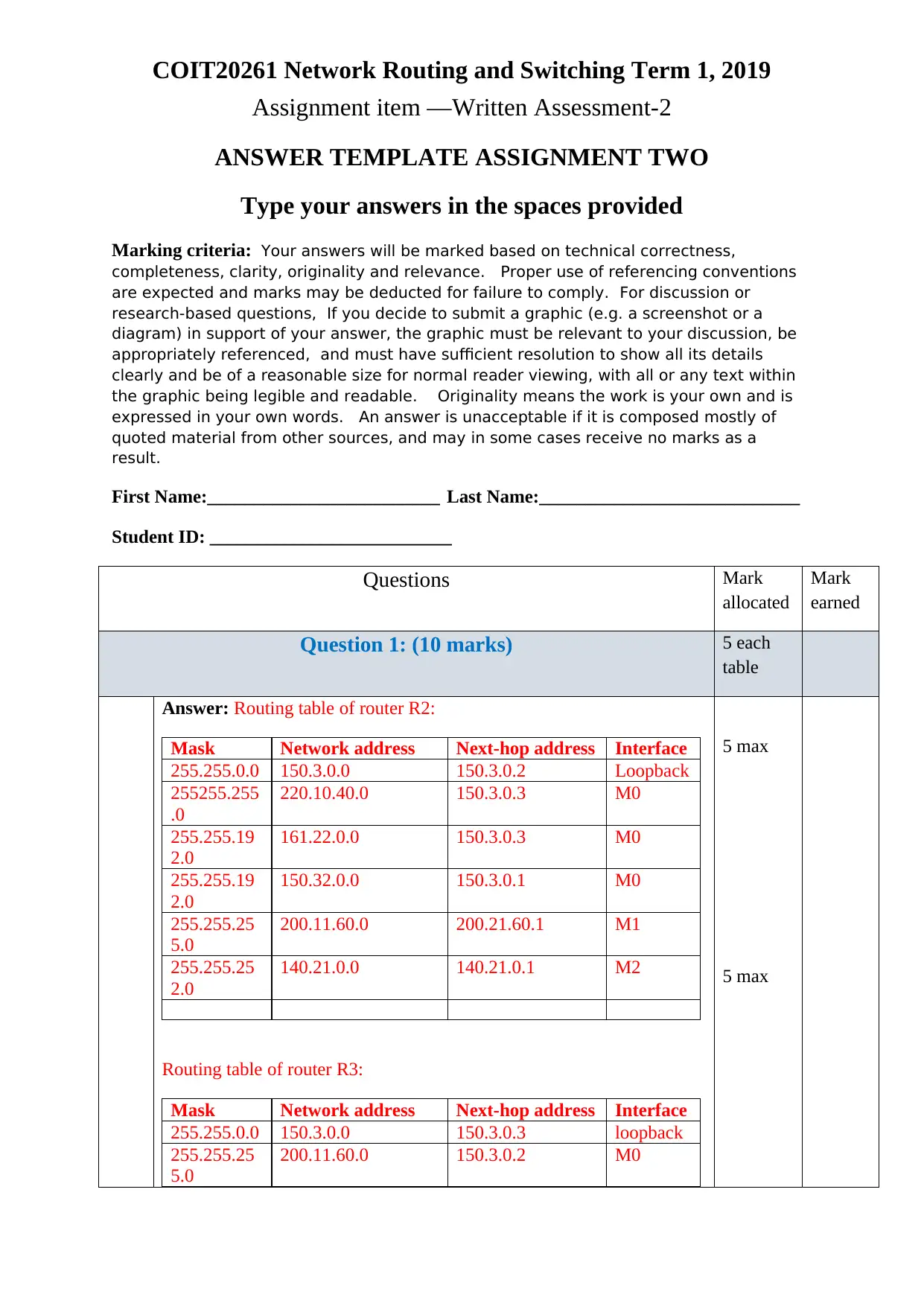
COIT20261 Network Routing and Switching Term 1, 2019
Assignment item —Written Assessment-2
ANSWER TEMPLATE ASSIGNMENT TWO
Type your answers in the spaces provided
Marking criteria: Your answers will be marked based on technical correctness,
completeness, clarity, originality and relevance. Proper use of referencing conventions
are expected and marks may be deducted for failure to comply. For discussion or
research-based questions, If you decide to submit a graphic (e.g. a screenshot or a
diagram) in support of your answer, the graphic must be relevant to your discussion, be
appropriately referenced, and must have sufficient resolution to show all its details
clearly and be of a reasonable size for normal reader viewing, with all or any text within
the graphic being legible and readable. Originality means the work is your own and is
expressed in your own words. An answer is unacceptable if it is composed mostly of
quoted material from other sources, and may in some cases receive no marks as a
result.
First Name:_________________________ Last Name:____________________________
Student ID: __________________________
Questions Mark
allocated
Mark
earned
Question 1: (10 marks) 5 each
table
Answer: Routing table of router R2:
Mask Network address Next-hop address Interface
255.255.0.0 150.3.0.0 150.3.0.2 Loopback
255255.255
.0
220.10.40.0 150.3.0.3 M0
255.255.19
2.0
161.22.0.0 150.3.0.3 M0
255.255.19
2.0
150.32.0.0 150.3.0.1 M0
255.255.25
5.0
200.11.60.0 200.21.60.1 M1
255.255.25
2.0
140.21.0.0 140.21.0.1 M2
Routing table of router R3:
Mask Network address Next-hop address Interface
255.255.0.0 150.3.0.0 150.3.0.3 loopback
255.255.25
5.0
200.11.60.0 150.3.0.2 M0
5 max
5 max
Assignment item —Written Assessment-2
ANSWER TEMPLATE ASSIGNMENT TWO
Type your answers in the spaces provided
Marking criteria: Your answers will be marked based on technical correctness,
completeness, clarity, originality and relevance. Proper use of referencing conventions
are expected and marks may be deducted for failure to comply. For discussion or
research-based questions, If you decide to submit a graphic (e.g. a screenshot or a
diagram) in support of your answer, the graphic must be relevant to your discussion, be
appropriately referenced, and must have sufficient resolution to show all its details
clearly and be of a reasonable size for normal reader viewing, with all or any text within
the graphic being legible and readable. Originality means the work is your own and is
expressed in your own words. An answer is unacceptable if it is composed mostly of
quoted material from other sources, and may in some cases receive no marks as a
result.
First Name:_________________________ Last Name:____________________________
Student ID: __________________________
Questions Mark
allocated
Mark
earned
Question 1: (10 marks) 5 each
table
Answer: Routing table of router R2:
Mask Network address Next-hop address Interface
255.255.0.0 150.3.0.0 150.3.0.2 Loopback
255255.255
.0
220.10.40.0 150.3.0.3 M0
255.255.19
2.0
161.22.0.0 150.3.0.3 M0
255.255.19
2.0
150.32.0.0 150.3.0.1 M0
255.255.25
5.0
200.11.60.0 200.21.60.1 M1
255.255.25
2.0
140.21.0.0 140.21.0.1 M2
Routing table of router R3:
Mask Network address Next-hop address Interface
255.255.0.0 150.3.0.0 150.3.0.3 loopback
255.255.25
5.0
200.11.60.0 150.3.0.2 M0
5 max
5 max
Secure Best Marks with AI Grader
Need help grading? Try our AI Grader for instant feedback on your assignments.
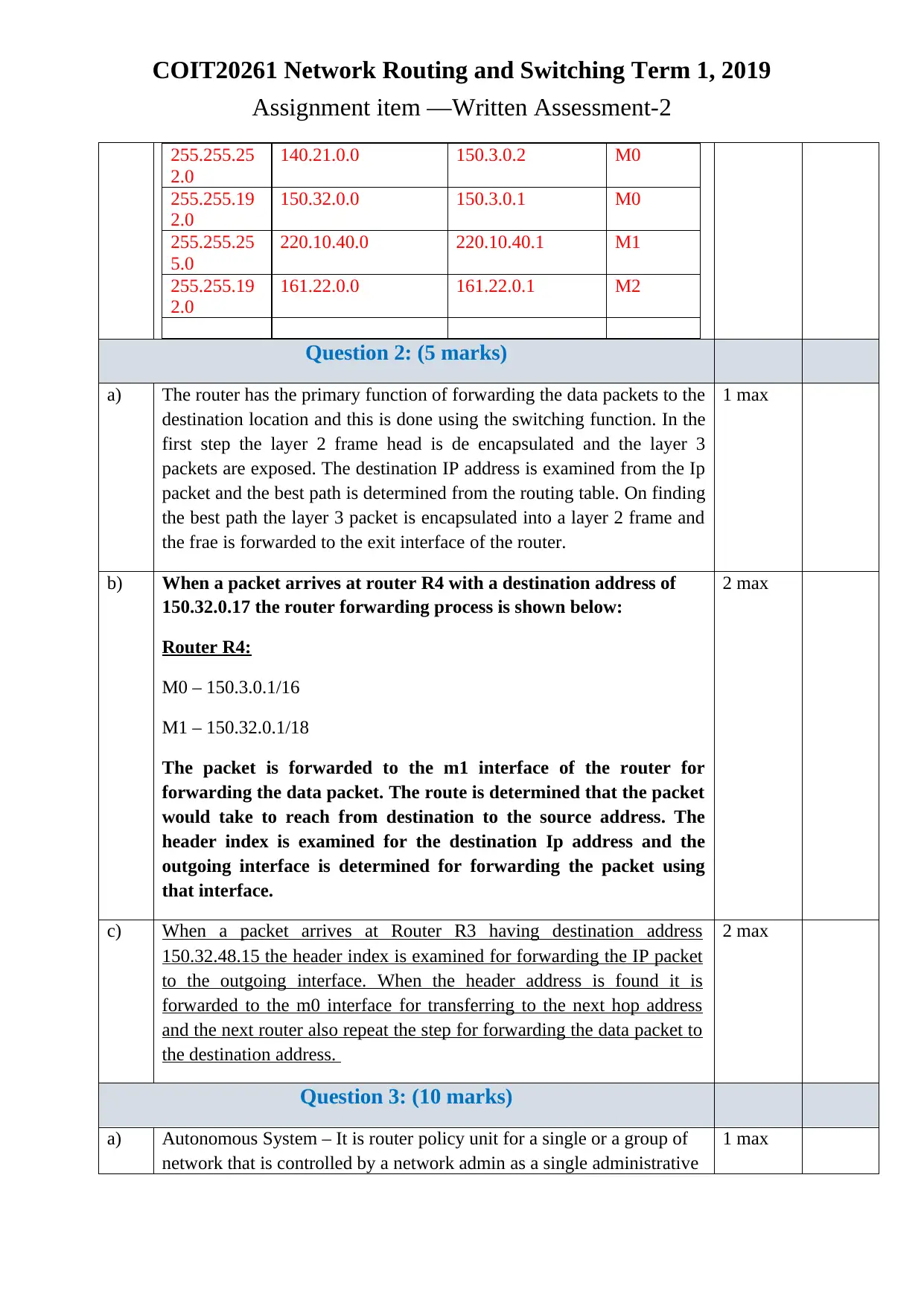
COIT20261 Network Routing and Switching Term 1, 2019
Assignment item —Written Assessment-2
255.255.25
2.0
140.21.0.0 150.3.0.2 M0
255.255.19
2.0
150.32.0.0 150.3.0.1 M0
255.255.25
5.0
220.10.40.0 220.10.40.1 M1
255.255.19
2.0
161.22.0.0 161.22.0.1 M2
Question 2: (5 marks)
a) The router has the primary function of forwarding the data packets to the
destination location and this is done using the switching function. In the
first step the layer 2 frame head is de encapsulated and the layer 3
packets are exposed. The destination IP address is examined from the Ip
packet and the best path is determined from the routing table. On finding
the best path the layer 3 packet is encapsulated into a layer 2 frame and
the frae is forwarded to the exit interface of the router.
1 max
b) When a packet arrives at router R4 with a destination address of
150.32.0.17 the router forwarding process is shown below:
Router R4:
M0 – 150.3.0.1/16
M1 – 150.32.0.1/18
The packet is forwarded to the m1 interface of the router for
forwarding the data packet. The route is determined that the packet
would take to reach from destination to the source address. The
header index is examined for the destination Ip address and the
outgoing interface is determined for forwarding the packet using
that interface.
2 max
c) When a packet arrives at Router R3 having destination address
150.32.48.15 the header index is examined for forwarding the IP packet
to the outgoing interface. When the header address is found it is
forwarded to the m0 interface for transferring to the next hop address
and the next router also repeat the step for forwarding the data packet to
the destination address.
2 max
Question 3: (10 marks)
a) Autonomous System – It is router policy unit for a single or a group of
network that is controlled by a network admin as a single administrative
1 max
Assignment item —Written Assessment-2
255.255.25
2.0
140.21.0.0 150.3.0.2 M0
255.255.19
2.0
150.32.0.0 150.3.0.1 M0
255.255.25
5.0
220.10.40.0 220.10.40.1 M1
255.255.19
2.0
161.22.0.0 161.22.0.1 M2
Question 2: (5 marks)
a) The router has the primary function of forwarding the data packets to the
destination location and this is done using the switching function. In the
first step the layer 2 frame head is de encapsulated and the layer 3
packets are exposed. The destination IP address is examined from the Ip
packet and the best path is determined from the routing table. On finding
the best path the layer 3 packet is encapsulated into a layer 2 frame and
the frae is forwarded to the exit interface of the router.
1 max
b) When a packet arrives at router R4 with a destination address of
150.32.0.17 the router forwarding process is shown below:
Router R4:
M0 – 150.3.0.1/16
M1 – 150.32.0.1/18
The packet is forwarded to the m1 interface of the router for
forwarding the data packet. The route is determined that the packet
would take to reach from destination to the source address. The
header index is examined for the destination Ip address and the
outgoing interface is determined for forwarding the packet using
that interface.
2 max
c) When a packet arrives at Router R3 having destination address
150.32.48.15 the header index is examined for forwarding the IP packet
to the outgoing interface. When the header address is found it is
forwarded to the m0 interface for transferring to the next hop address
and the next router also repeat the step for forwarding the data packet to
the destination address.
2 max
Question 3: (10 marks)
a) Autonomous System – It is router policy unit for a single or a group of
network that is controlled by a network admin as a single administrative
1 max
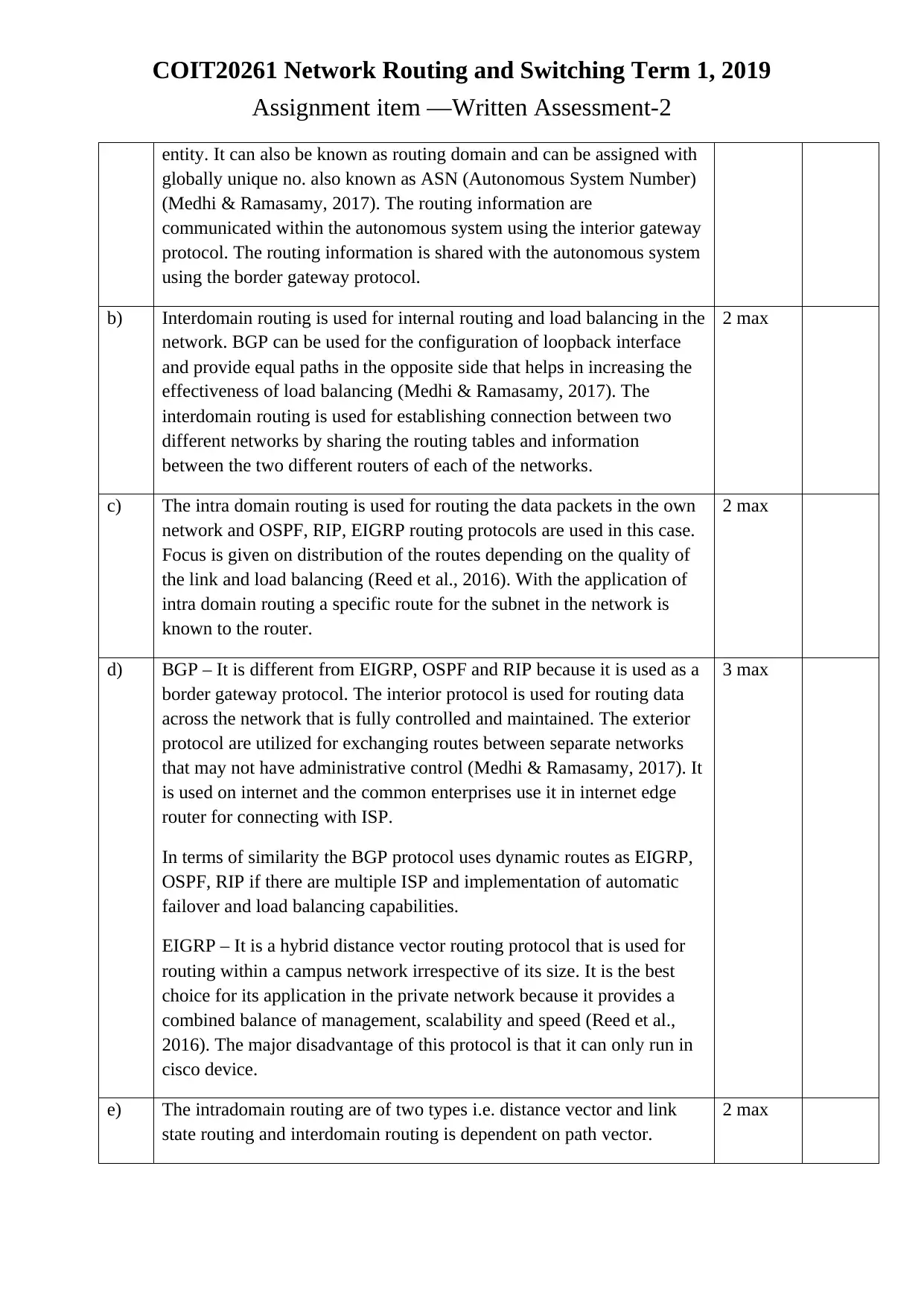
COIT20261 Network Routing and Switching Term 1, 2019
Assignment item —Written Assessment-2
entity. It can also be known as routing domain and can be assigned with
globally unique no. also known as ASN (Autonomous System Number)
(Medhi & Ramasamy, 2017). The routing information are
communicated within the autonomous system using the interior gateway
protocol. The routing information is shared with the autonomous system
using the border gateway protocol.
b) Interdomain routing is used for internal routing and load balancing in the
network. BGP can be used for the configuration of loopback interface
and provide equal paths in the opposite side that helps in increasing the
effectiveness of load balancing (Medhi & Ramasamy, 2017). The
interdomain routing is used for establishing connection between two
different networks by sharing the routing tables and information
between the two different routers of each of the networks.
2 max
c) The intra domain routing is used for routing the data packets in the own
network and OSPF, RIP, EIGRP routing protocols are used in this case.
Focus is given on distribution of the routes depending on the quality of
the link and load balancing (Reed et al., 2016). With the application of
intra domain routing a specific route for the subnet in the network is
known to the router.
2 max
d) BGP – It is different from EIGRP, OSPF and RIP because it is used as a
border gateway protocol. The interior protocol is used for routing data
across the network that is fully controlled and maintained. The exterior
protocol are utilized for exchanging routes between separate networks
that may not have administrative control (Medhi & Ramasamy, 2017). It
is used on internet and the common enterprises use it in internet edge
router for connecting with ISP.
In terms of similarity the BGP protocol uses dynamic routes as EIGRP,
OSPF, RIP if there are multiple ISP and implementation of automatic
failover and load balancing capabilities.
EIGRP – It is a hybrid distance vector routing protocol that is used for
routing within a campus network irrespective of its size. It is the best
choice for its application in the private network because it provides a
combined balance of management, scalability and speed (Reed et al.,
2016). The major disadvantage of this protocol is that it can only run in
cisco device.
3 max
e) The intradomain routing are of two types i.e. distance vector and link
state routing and interdomain routing is dependent on path vector.
2 max
Assignment item —Written Assessment-2
entity. It can also be known as routing domain and can be assigned with
globally unique no. also known as ASN (Autonomous System Number)
(Medhi & Ramasamy, 2017). The routing information are
communicated within the autonomous system using the interior gateway
protocol. The routing information is shared with the autonomous system
using the border gateway protocol.
b) Interdomain routing is used for internal routing and load balancing in the
network. BGP can be used for the configuration of loopback interface
and provide equal paths in the opposite side that helps in increasing the
effectiveness of load balancing (Medhi & Ramasamy, 2017). The
interdomain routing is used for establishing connection between two
different networks by sharing the routing tables and information
between the two different routers of each of the networks.
2 max
c) The intra domain routing is used for routing the data packets in the own
network and OSPF, RIP, EIGRP routing protocols are used in this case.
Focus is given on distribution of the routes depending on the quality of
the link and load balancing (Reed et al., 2016). With the application of
intra domain routing a specific route for the subnet in the network is
known to the router.
2 max
d) BGP – It is different from EIGRP, OSPF and RIP because it is used as a
border gateway protocol. The interior protocol is used for routing data
across the network that is fully controlled and maintained. The exterior
protocol are utilized for exchanging routes between separate networks
that may not have administrative control (Medhi & Ramasamy, 2017). It
is used on internet and the common enterprises use it in internet edge
router for connecting with ISP.
In terms of similarity the BGP protocol uses dynamic routes as EIGRP,
OSPF, RIP if there are multiple ISP and implementation of automatic
failover and load balancing capabilities.
EIGRP – It is a hybrid distance vector routing protocol that is used for
routing within a campus network irrespective of its size. It is the best
choice for its application in the private network because it provides a
combined balance of management, scalability and speed (Reed et al.,
2016). The major disadvantage of this protocol is that it can only run in
cisco device.
3 max
e) The intradomain routing are of two types i.e. distance vector and link
state routing and interdomain routing is dependent on path vector.
2 max
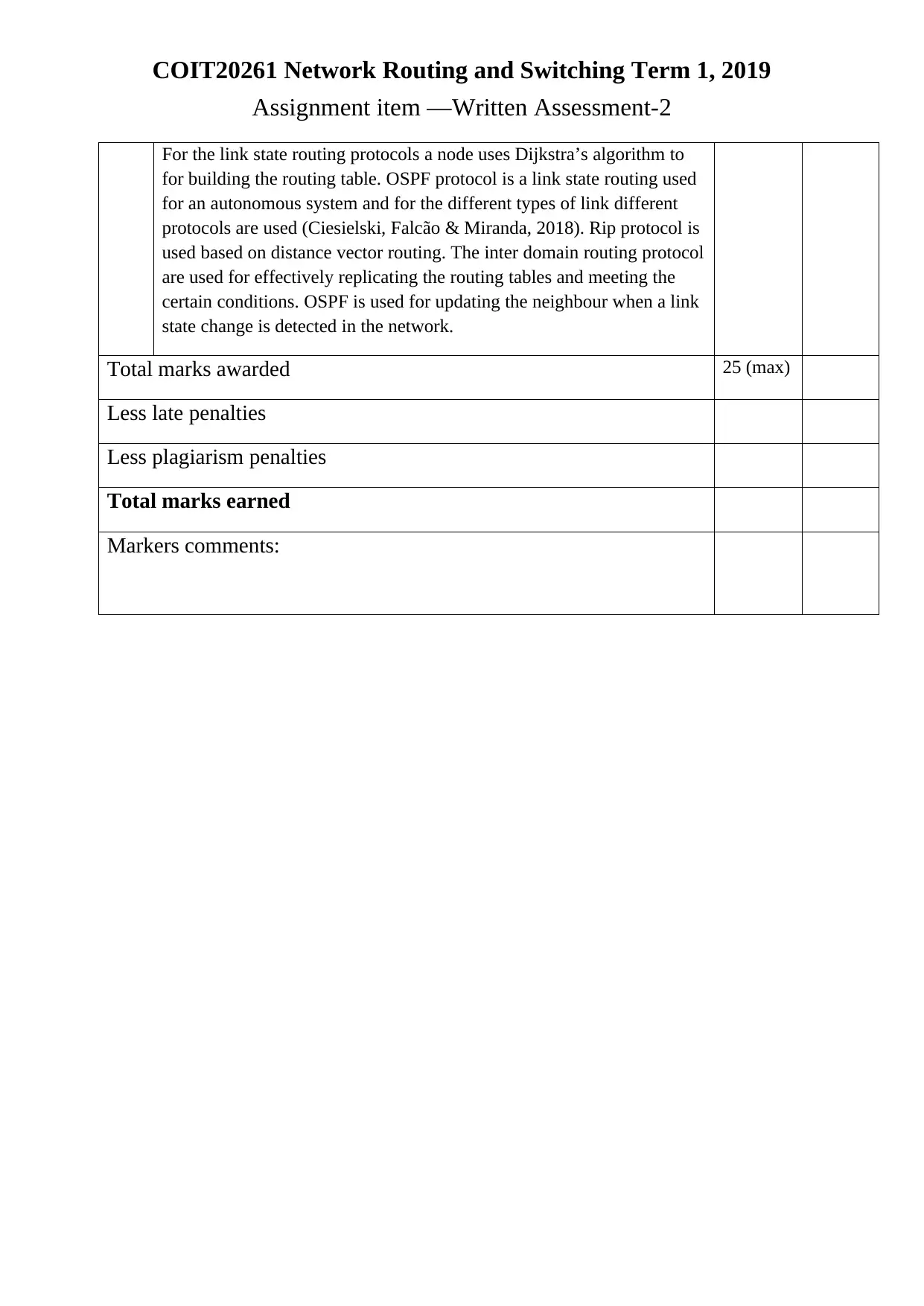
COIT20261 Network Routing and Switching Term 1, 2019
Assignment item —Written Assessment-2
For the link state routing protocols a node uses Dijkstra’s algorithm to
for building the routing table. OSPF protocol is a link state routing used
for an autonomous system and for the different types of link different
protocols are used (Ciesielski, Falcão & Miranda, 2018). Rip protocol is
used based on distance vector routing. The inter domain routing protocol
are used for effectively replicating the routing tables and meeting the
certain conditions. OSPF is used for updating the neighbour when a link
state change is detected in the network.
Total marks awarded 25 (max)
Less late penalties
Less plagiarism penalties
Total marks earned
Markers comments:
Assignment item —Written Assessment-2
For the link state routing protocols a node uses Dijkstra’s algorithm to
for building the routing table. OSPF protocol is a link state routing used
for an autonomous system and for the different types of link different
protocols are used (Ciesielski, Falcão & Miranda, 2018). Rip protocol is
used based on distance vector routing. The inter domain routing protocol
are used for effectively replicating the routing tables and meeting the
certain conditions. OSPF is used for updating the neighbour when a link
state change is detected in the network.
Total marks awarded 25 (max)
Less late penalties
Less plagiarism penalties
Total marks earned
Markers comments:
Secure Best Marks with AI Grader
Need help grading? Try our AI Grader for instant feedback on your assignments.
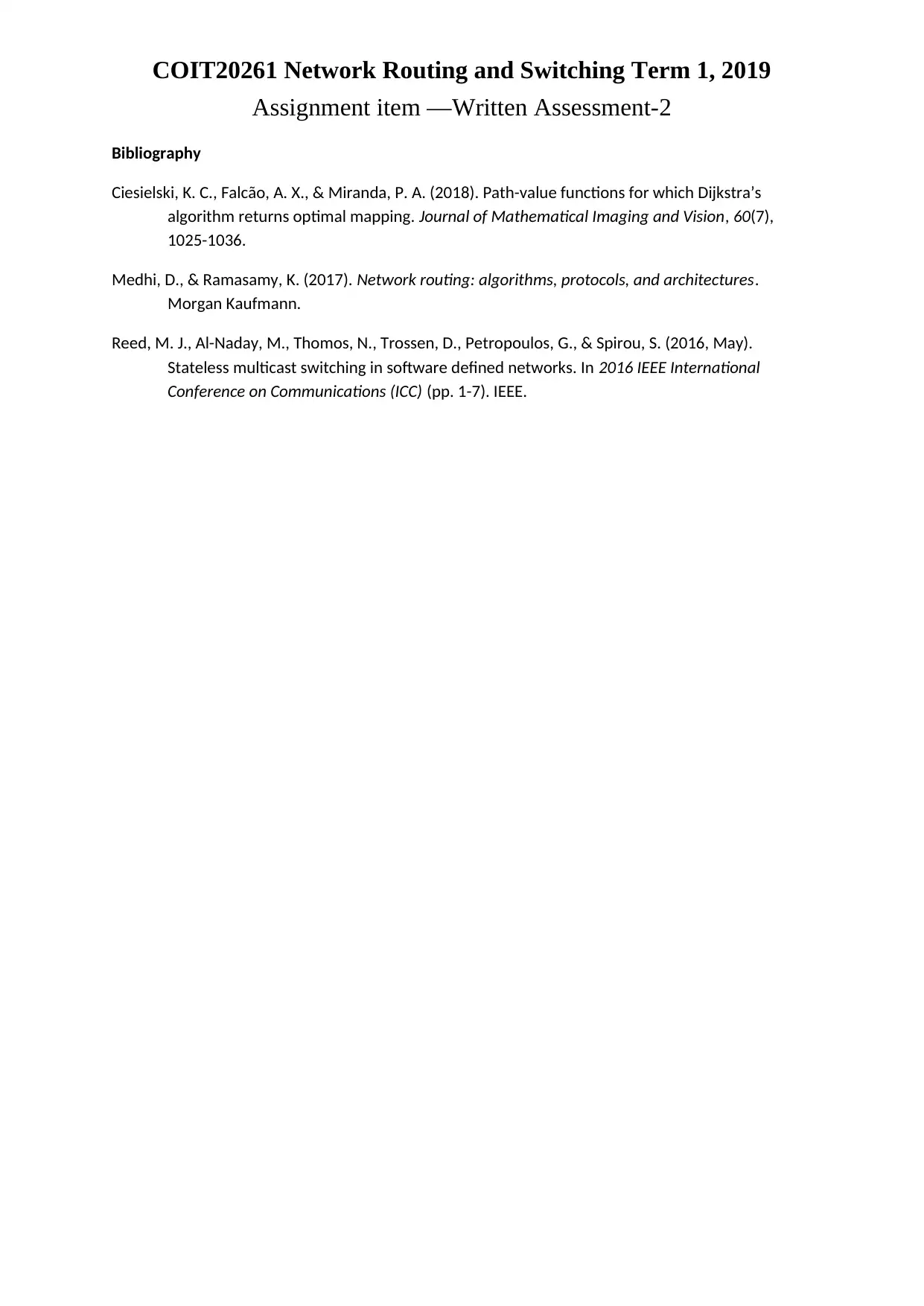
COIT20261 Network Routing and Switching Term 1, 2019
Assignment item —Written Assessment-2
Bibliography
Ciesielski, K. C., Falcão, A. X., & Miranda, P. A. (2018). Path-value functions for which Dijkstra’s
algorithm returns optimal mapping. Journal of Mathematical Imaging and Vision, 60(7),
1025-1036.
Medhi, D., & Ramasamy, K. (2017). Network routing: algorithms, protocols, and architectures.
Morgan Kaufmann.
Reed, M. J., Al-Naday, M., Thomos, N., Trossen, D., Petropoulos, G., & Spirou, S. (2016, May).
Stateless multicast switching in software defined networks. In 2016 IEEE International
Conference on Communications (ICC) (pp. 1-7). IEEE.
Assignment item —Written Assessment-2
Bibliography
Ciesielski, K. C., Falcão, A. X., & Miranda, P. A. (2018). Path-value functions for which Dijkstra’s
algorithm returns optimal mapping. Journal of Mathematical Imaging and Vision, 60(7),
1025-1036.
Medhi, D., & Ramasamy, K. (2017). Network routing: algorithms, protocols, and architectures.
Morgan Kaufmann.
Reed, M. J., Al-Naday, M., Thomos, N., Trossen, D., Petropoulos, G., & Spirou, S. (2016, May).
Stateless multicast switching in software defined networks. In 2016 IEEE International
Conference on Communications (ICC) (pp. 1-7). IEEE.
1 out of 5
Related Documents
Your All-in-One AI-Powered Toolkit for Academic Success.
+13062052269
info@desklib.com
Available 24*7 on WhatsApp / Email
![[object Object]](/_next/static/media/star-bottom.7253800d.svg)
Unlock your academic potential
© 2024 | Zucol Services PVT LTD | All rights reserved.





